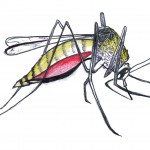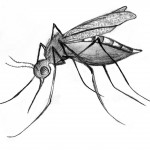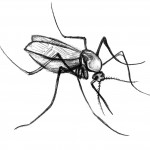
John Shepard spends his summers hunched over a microscope, identifying mosquitoes trapped in the Connecticut mosquito surveillance program. Shepard oversaw the identification and sorting of 115,725 mosquitoes last year. The year before it was closer to three hundred thousand. He examined probably forty thousand under the microscope himself.
Connecticut is home to over fifty different species of mosquitoes, thirty of which are commonly found in the statewide traps. But one morning in July 2006, Shepard saw a distinct, uncommon species under his microscope. Silvery white stripes lined the thorax and legs of the black insect. Shepard had seen such markings before and quickly identified the species as Aedes albopictus, the Asian tiger mosquito, a carrier of numerous deadly diseases. He checked the sample container to see where the mosquito had been trapped. He knew the place well—the Exeter Energy Tire Incinerator in Sterling, Connecticut.
Shepard shared his discovery with his colleague Dr. Theodore Andreadis, the chief medical entomologist at the Connecticut Agricultural Experiment Station in New Haven, whose office adjoins the lab where Shepard works. Andreadis, who oversees the surveillance program and has extensive training with mosquitoes, had seen the species before and was well aware of the threat caused by its growing global presence.
Mosquitoes are picky eaters. Of all the species of the insect found in Connecticut, only a few are known to feed on humans. Andreadis and the surveillance team have analyzed the blood meals of mosquitoes and have isolated the species that readily feed on humans. They vary according to geography but include Ochlerotatus sollicitans, Aedes vexans, Aedes japonicus, Culex pipiens, and, of course, Aedes albopictus. Shepard has extensive firsthand experience: a number of close-up pictures on the wall feature his hand being fed on by various mosquitoes.
The Asian tiger, though, is different from the others. It feeds on anything that moves. In populated areas it is a serious human pest. “It will literally hunt you down,” Shepard explained to me.

Andreadis knew that the Asian tiger mosquito had caused an outbreak of Chikungunya—a disease marked by high fever, nausea, vomiting, muscle pain, rash, and joint pain—on the French island of Réunion the year before. Well over a hundred thousand people fell sick. More gravely, the Asian tiger is a vector of Dengue virus, a disease that has recently reemerged in the United States. In its most severe form, which is called Dengue hemorrhagic fever, patients experience flu-like symptoms at the onset, followed by severe bleeding from the nose and mouth and bleeding under the skin. In laboratory studies, the Asian tiger has successfully carried five other viruses, including Eastern equine encephalitis and yellow fever. Shepard warned that it could also be a vector for Japanese encephalitis as well as other, yet-to-be-discovered viruses. And this pernicious creature had just arrived in Connecticut.
Battling mosquitoes and defending against the diseases they carry is a grueling counterinsurgency, and the intelligence gathered at the Experiment Station is vitally important to public health. When the researchers there isolate a virus, they immediately notify officials at the Department of Health. If a virus is regionally concentrated or if a certain mosquito species is showing signs of increased viral activity, the program can advise local officials to spray insecticides or initiate other control mechanisms. According to Shepard, the goal is to prevent outbreaks not just of West Nile but of any of the many mosquito-borne viruses found in the state. The surveillance program’s breadth across the state also allows for the monitoring of new and invasive species, like the Asian tiger mosquito.
Not even the most sophisticated prevention techniques, however, can protect against an enemy that remains invisible.
…
The researchers at the Experiment Station are all too familiar with the dangers of mosquito-born diseases. Culex pipiens, a less dangerous vector than the Asian tiger, was the species responsible for the 1999 West Nile epidemic in New York. “It was insane. It was 24/7. It was very explosive,” recalls Andreadis. News coverage was around the clock. Trucks were spraying insecticide all over New York City. Calls were coming in daily to the station reporting dead birds—crows were falling out of the sky.

No one knows for sure how the virus got to the United States. Because the first human cases were in Queens near two airports, the disease likely arrived on an airplane. Andreadis guesses that the culprit was an infected mosquito on a commercial transcontinental flight. But it could just as well have been an infected human returning from abroad, or a bird or mosquito in a ship’s hold, he said. The virus that was eventually isolated matched most closely a strain that had caused a minor outbreak among an elderly population in Israel in 1957, so there was some speculation that it originated there.
In the first chaotic days and weeks of the outbreak, though, no one realized that the New York City cases were actually West Nile. The virus had never been seen in the Western Hemisphere before, and no labs in the United States had West Nile isolates to test against. The New York virus was assumed to be St. Louis encephalitis, another disease for which Culex is the primary vector.
On September 4, 1999, John Anderson, then director of the Experiment Station, read a story in the New York Times under the headline, “Encephalitis Strikes 3 People, 1 Fatally, In Queens, City Says.” It was a Saturday, and Anderson was working on houseflies somewhere in Eastern Connecticut. He heard similar reports of an outbreak on the radio and realized that something was up. “I got a call that night asking if I wanted to sit in on a telephone call the next day, Sunday, with the CDC and people from New York and other health directors from the region.” (The CDC is the federal Centers for Disease Control and Prevention.) Anderson called a technician in his lab to see if they had ever grown the St. Louis encephalitis cell line. He needed something against which to test any viruses he might isolate. After the call he went out to Greenwich and Stamford to set mosquito traps.
Anderson couldn’t simply walk into people’s yards and place traps on a Sunday in Greenwich, so he requested a police escort. None of this was new to Anderson. Two years earlier he had established a small-scale mosquito surveillance program in Connecticut after an outbreak of Eastern equine encephalitis on the Rhode Island border. But this time, acquiring information about the spread of the virus would be critical to prevention efforts, and the Experiment Station had the regions’ only facilities able to test mosquito samples and track the outbreak.
A few days later a local Greenwich paper published a story about Anderson’s activities. That day he got a call from the Innis Arden Golf Club in Old Greenwich. Members there were worried and had begun to complain of mosquitoes. The course thought it would be best to set a trap. “And it was there we isolated this virus from two species of mosquitoes,” Anderson says.
Meanwhile, crows continued to die, and one dead bird made it from the coastal town of Norwalk to the University of Connecticut in Hartford. Scientists there knew Anderson was working on the outbreak, and they called to offer him the bird’s brain. “Bird brains, you know, they’re not very large. A crow brain is about like that size,” Anderson tells me, holding up a hand with thumb and forefinger touching. “And I just cut it in pie slices and isolated virus in every section.” Eventually Anderson tested the three separate virus isolates—the bird and two mosquito species—against antibodies from St. Louis encephalitis and found that the public health community’s prior thinking had been wrong. The disease was not St. Louis. The team then analyzed the structural makeup of the virus’s RNA. The sequence most closely matched a sequence of West Nile virus that had been isolated and recorded years earlier in Romania.
After scrambling day and night to pull a paper together, Anderson’s team published their findings in the December 1999 issue of Science. Anderson slides his copy across the conference room table where we’ve met. The abstract warns, “If established in North America, WN virus will likely have severe effects on human health and on the health of populations of birds.”
At that point, no one knew whether or not West Nile would successfully overwinter. In the earlier outbreaks in Europe it had failed to survive colder winter temperatures, and most in the United States thought the disease would not reappear the following spring.
But by 2003, “we had the largest epidemic of a mosquito-borne disease ever in North America,” Andreadis said. The years from 2004 to 2008 were the “establishment phase.” The number of human cases settled to around a thousand per year, and the disease became a permanent health threat.
In order for an epidemic to occur, not only must a virus arrive in the United States, but it must also find a viable mosquito vector species that feeds on mammals—more specifically, humans—and that lives in urban and suburban areas. Otherwise, the virus poses no threat to humans.
Mosquitoes are finicky about where they breed. Some prefer natural, dry habitats, such as holes and crevices in trees and rocks. Others are simple container breeders and are happy anywhere water pools. Culex pipiens prefers artificial containers or stagnant pools with organic content, and it is highly tolerant of polluted water. In short, Culex mosquitoes love basements, cellars, and sewers—all the byproducts of densely populated urban areas.
In his office at the back of the lab, Dr. Andreadis pulls up a map on his computer screen. It shows the state of Connecticut with black circles marking sites where West Nile has been isolated from mosquitoes (seventy percent of West Nile isolates come from Culex pipiens). The dots are clustered along the I-95 corridor, a stretch that includes the cities of Greenwich, Stamford, Bridgeport, and New Haven, and around the state capital of Hartford. In Culex pipiens, West Nile found the perfect vector.
…
Aedes albopictues—the Asian tiger—may prove itself a similarly menacing vector for disease. No one knows more about the threat it poses than Dr. Paul Reiter, now the director of the Insects and Infectious Diseases Unit at the Institut Pasteur in Paris, who was the first person to find an Asian tiger mosquito in the Western Hemisphere. Since that fateful afternoon in a Memphis, Tennessee, cemetery in the fall of 1983, Reiter has tracked the global invasion of Aedes albopictus into 36 states and nearly as many countries….
Reiter stumbled into a life devoted to mosquitoes while working on a dissertation on the biochemistry of schizophrenia. “I got very bored,” he told me over the phone from his home in Paris. He later joked that he was tired of shuttling bottles of urine from schizophrenic patients to the lab for analysis. “There was a kind of Peace Corps type advert to go work in the Cayman Islands in the mosquito control unit. So I thought I’d do that for a year, and I got stuck.” After the Cayman Islands, Reiter relocated to the CDC, where he was working in 1983.
That year, the CDC sent Reiter to Tennessee to study St. Louis encephalitis. He spent his days collecting mosquitoes for virus isolation in the fertile breeding grounds of culverts and storm sewers. Reiter, who is six feet tall, found it incredibly challenging to work hunched over in the five-foot diameter sewers. So he invented a trap that would allow him to collect Culex mosquitoes in open areas. He baited the trap with a putrid infusion he made by steeping hay in water for about a week, which was particularly attractive to Culex females ready to lay eggs. Reiter’s trap is used today by mosquito surveillance programs around the country, including Connecticut’s.
One evening Reiter got a call from his colleague Dick Darsie, the man tasked with sorting through all Reiter’s mosquitoes before testing. “He said, ‘Paul, you’ll never guess what I’ve found in your collections.’ And so I tried to guess and of course I got it wrong,” Reiter recalled. Darsie had found an Asian tiger mosquito. Reiter didn’t doubt him—Darsie knew his mosquitoes well and had worked on the species in South Asia years before. Reiter took the discovery to the Tennessee Department of Health but was offered no support for further research.
Reiter found no more albopictus for the next few years, and eventually almost forgot about the species. He still wonders how that one mosquito got to Memphis. His only theory is that it came in a mail shipment from Houston. Both Houston and Memphis have large mail sorting facilities; Houston is a major port, and, as it later turned out, it was albopictus’ probable point of entry when it eventually took hold in the United States. The mail facility in Memphis was just across the street from the cemetery where Reiter trapped that first mosquito.
“I looked at the place on Google the other day and could see the exact spot where the trap was,” Reiter told me almost nostalgically. “Perhaps we can put a plaque there one day.”
…
In 1986 the CDC asked Reiter to go down to Houston. Reports were coming in of a new mosquito, and descriptions suggested it might be the Asian tiger. “Obviously I was the expert,” Reiter joked, “because I had caught one mosquito.”
In Houston, Reiter and a colleague spent most of their time exploring tire dumps. Tire piles are just about the perfect breeding sites for mosquitoes. When water gets in a tire it never leaves, and it collects organic material that is very attractive to female mosquitoes. They were finishing up at a site one afternoon when a pickup truck came down the road and stopped about 150 yards from where Reiter had parked. Two men got out and started rummaging through the tire pile. Reiter watched as they started throwing some of the tires he had marked into their truck. Reiter had planned to come back to check on breeding mosquitoes, so he went up to them and asked what they were doing with the tires. The tires, it turned out, would be shipped to Mexico and Guatemala. “I thought, ‘Oh, for crying out loud, they’re going to be shipping out the mosquitoes as well’,” Reiter recalled. “All of the tires had water in them and all of them had lots of mosquitoes.”
Reiter learned that the men’s company also imported tires from Japan. “And that’s how I stumbled on the fact that there’s this incredible trade in used tires.”
The Japanese were exporting used tires to some 140 or 150 countries. The United States exported them to over a hundred countries. Tires were being shipped to the United States for recapping—many countries have regulations that allow tires to be recapped or retreaded. Airplane tires can be recapped nine times, Reiter learned. And so a trade in what appeared to be useless used rubber was in fact a lucrative global industry. “The Europeans were importing them. I told them that they should not, but of course nobody stopped, and now Europe is full of albopictus. Oh, it’s everywhere. It’s in about four or five countries in West Africa. It’s certainly in Lebanon and Syria. It’s going to be universal, I think.”
…
From its entrance into the port of Houston, the Asian tiger stalked its way east and up the Atlantic seaboard. Today, the front line in the battle against the species lies somewhere along the Connecticut-New York-New Jersey border. At the Experiment Station in New Haven, Shepard and Andreadis are on high alert.
When the two found the first albopictus in Connecticut in 2006, they were not surprised. Andreadis guessed almost immediately how it arrived. “There was no question it was by the transportation of used tires,” he tells me. All mosquitoes collected in the surveillance program’s traps are identified and sorted by species and trap location, and the Asian tiger mosquito that Shepard had identified was from a trap at the Exeter Energy Tire Incinerator. The only question that mattered was whether or not the mosquito would establish a permanent presence in the state.
To do so, the Asian tiger’s eggs needed to last through the cold Connecticut winter. After the first Asian tiger was found at the Sterling tire plant, surveillance staff returned to the facility weekly for the remainder of the season. They found that the mosquito had successfully entrenched itself in the woodlands surrounding the tire facility, and females were beginning to lay eggs in traps that Andreadis’s team had placed. When they returned in early summer of 2007, though, they found no larvae in the traps—the eggs had died during the winter—and no host-seeking females in the surrounding woodlands.
The results of their study, which Andreadis published in a 2009 paper in the Journal of the American Mosquito Control Association, identified a temperature barrier. South of the barrier, where the average January temperature is above zero degrees Celsius, the mosquito had successfully established itself. In New York City, where the average January temperature is 0.14 degrees Celsius, albopictus resides in every major borough. Other surveillance programs had found the species overwintering in New Jersey and Pennsylvania, but not north of the zero degree barrier. A line on a map to mark this barrier would rise through central Pennsylvania, stretch across northern New Jersey, and follow the eastern seaboard along the coast of the Long Island Sound out to sea. Average January temperatures all across Connecticut are just slightly below the zero degree mark.
According to Andreadis’s paper, the Sterling tire recycling plant often receives tires from out of state. The Asian tiger likely arrived inside a tire on one of these shipments, probably from New Jersey. (Exeter Energy is undergoing an acquisition and declined to comment for this article.) Though the mosquitoes have so far failed to survive the winters here, average global temperatures are on the rise, and if Connecticut warms even slightly, we may well find the Asian tiger residing permanently in our backyards.
John Shepard explained all of this to me in a small closet at the end of a long hall on the second floor of the Slate laboratory building of the Connecticut Agricultural Experiment Station. An independent state agency, the Experiment Station is cramped onto a small campus in the midst of the leafy residential Prospect Hill neighborhood just minutes north of Yale. All states have experiment stations, and Connecticut’s is the oldest, founded in 1875. The station conducts scientific research focusing on agriculture and the environment. A scientist first bred hybrid corn here in 1914. Since its founding, the station’s motto has been “Putting Science to Work for Society.”
Shepard brought me to this closet—“insectary” is the preferred term—after his colleague, Dr. Melissa Hardstone, came to tell him that she was “going to get the guinea pig.” I asked what this meant, and Shepard led me into the cramped, fluorescently lit, artificially humidified room. Here, the researchers keep live colonies of eight species of mosquito in wire-mesh cages—including certain species not kept in colonies anywhere else in the country.
At the end of a shoulder-height shelf against the back wall, one of these cages contained a guinea pig with a shaved back. The white rodent was in its own wire cage, unable to move and subject to hundreds of Aedes aegypti mosquitoes. Its back was covered in small red bites. Hardstone insisted that the guinea pig doesn’t mind the treatment and, in fact, eagerly shuffles into its confining cage each time it is sent to be fed on. The feeding protocols, I was assured, are approved by the United States Department of Agriculture and the Institutional Animal Care and Use Committee. The guinea pigs are used only for the species of mosquitoes known to feed on mammals. For others that prefer birds, a small button quail is used instead.
On a lower shelf on the adjacent wall, another cage was clearly labeled Aedes albopictus. This is one of the country’s few colonies of the Asian tiger.
These colonies are an important weapon in the arsenal of mosquito containment. Because the Experiment Station also has an enormous collection of live viruses and pathogens in a high-safety laboratory, researchers can study these diseases and the way they spread through their insect vectors.
When mosquitoes bite us, most of us are annoyed at the itch, but few are likely to worry about deadly tropical diseases. Shepard, because of his exposure to the myriad threats, tends to dwell on these more morbid possibilities. “I know when my kids get bit it’s probably nothing,” Shepard told me. “But I’m not immune to worrying. And my wife will say to me, ‘Are we safe here?’”
…
The decorations on the walls of the two main lab rooms of the Experiment Station’s Center for Vector Biology and Zoonotic Diseases (the official home of the mosquito surveillance program) tell almost every detail of the story of West Nile. There are newspaper clippings, cartoons, magazine covers, fridge magnets encouraging citizens to report dead birds, and a taxidermied crow.
The spread of West Nile through Culex pipiens tells us much about the potential dangers of the Asian tiger mosquito. Put simply, just as Culex pipiens was waiting and ready when West Nile arrived, so too may the Asian tiger be waiting and ready when Dengue arrives. And if the connection seems far-fetched, consider the fact that Culex pipiens made its continental leap on shipping vessels—likely wooden sailing ships that crossed to the Americas in the seventeenth or eighteenth century—just as the Asian tiger snuck into Houston and now into Connecticut inside tires.
For the scientists who work in this field, it is not a question of if but when. For now, our best weapon is good intelligence, for which we can thank the Experiment Station. The lessons it learned in dealing with the West Nile threat—in ultimately failing to contain the virus, despite Anderson’s breakthrough in successfully identifying it—have been institutionalized in the form of the massive surveillance program and better communication with public health officials. “It sounds terribly trite, but expect the unexpected,” warns Reiter. “Who the heck knows what’s going to come in next?” Though we will surely deal with another deadly mosquito-borne outbreak, we will be better prepared for the next epidemic, even if the disease finds a vector in the Asian tiger mosquito.


